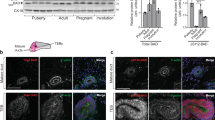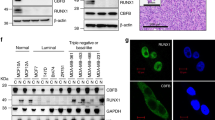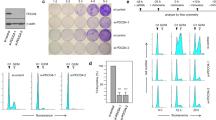Abstract
INT6/EIF3E has been implicated in breast tumorigenesis, but its functional activities remain poorly defined. We found that, repressing INT6 expression induced transformed properties in normal human mammary epithelium (MCF10A); in contrast, Int6 silencing induced apoptosis in HeLa cells. As in fission yeast, Int6 in human cells was required for assembly of active proteasomes. A reverse-phase protein array screen identified SRC3/AIB1 as one oncoprotein the level and stability of which increased when Int6 was silenced in MCF10A cells. Our data further show that Int6 binds SRC3 and its ubiquitin ligase Fbw7, thus perhaps mediating the interaction between SRC3–Fbw7 and proteasomes. Consistent with this, Int6 silencing did not increase SRC3 levels in HeLa cells, which have low Fbw7 levels. It is surprising that, however, polyubiquitylated proteins do not accumulate or may even decrease in Int6-silenced cells that contain defective proteasomes. Considering that decreased ubiquitin might explain this observation and that Int6 might control ubiquitin levels in its role as a subunit of eIF3 (eukaryote translation initiation factor 3), we found that silencing Int6 reduced monoubiquitin protein levels, which correlated with a shift of ubiquitin mRNAs from larger polysomes to non-translating ribosomes. In contrast, levels of many housekeeping proteins did not change. This apparent reduction in the translation of ubiquitin genes correlated with a modest reduction in protein synthesis rate and formation of large polysomes. To further determine whether Int6 can selectively control translation, we analyzed translation of different 5′-untranslated region reporters and found that indeed, loss of Int6 had differential effects on these reporters. Together the data suggest that Int6 depletion blocks ubiquitin-dependent proteolysis by decreasing both ubiquitin levels and the assembly of functional proteasome machinery, leading to accumulation of oncoproteins, such as SRC3 that can transform mammary epithelium. Our data also raise the possibility that Int6 can further fine-tune protein levels by selectively controlling translation of specific mRNAs.
This is a preview of subscription content, access via your institution
Access options
Subscribe to this journal
Receive 50 print issues and online access
$259.00 per year
only $5.18 per issue
Buy this article
- Purchase on Springer Link
- Instant access to full article PDF
Prices may be subject to local taxes which are calculated during checkout






Similar content being viewed by others
References
Akiyoshi Y, Clayton J, Phan L, Yamamoto M, Hinnebusch AG, Watanabe Y et al. (2001). Fission yeast homolog of murine Int-6 protein, encoded by mouse mammary tumor virus integration site, is associated with the conserved core subunits of eukaryotic translation initiation factor 3. J Biol Chem 276: 10056–10062.
Aravind L, Ponting CP . (1998). Homologues of 26S proteasome subunits are regulators of transcription and translation. Protein Sci 7: 1250–1254.
Asano K, Merrick WC, Hershey JW . (1997). The translational initiation factor eIF3-p48 subunit is encoded by int6, a site of frequent integration by the mouse mammary tumor virus genome. J Biol Chem 272: 23477–23480.
Bandyopadhyay A, Matsumoto T, Maitra U . (2000). Fission yeast Int6 is not essential for global translation initiation, but deletion of int6+ causes hypersensitivity to caffeine and affects spore formation. Mol Biol Cell 11: 4005–4018.
Braunstein S, Karpisheva K, Pola C, Goldberg J, Hochman T, Yee H et al. (2007). A hypoxia-controlled cap-dependent to cap-independent translation switch in breast cancer. Mol Cell 28: 501–512.
Byrd MP, Zamora M, Lloyd RE . (2005). Translation of eIF4GI proceeds from multiple mRNAs containing a novel cap-dependent IRES that is active during poliovirus infection. J Biol Chem 280: 18610–18622.
Crane R, Craig R, Murray R, Dunand-Sauthier I, Humphrey T, Norbury C . (2000). A fission yeast homolog of Int-6, the mammalian oncoprotein and eIF3 subunit, induces drug resistance when overexpressed. Mol Biol Cell 11: 3993–4003.
Dawson PJ, Wolman SR, Tait L, Heppner GH, Miller FR . (1996). MCF10AT: a model for the evolution of cancer from proliferative breast disease. Am J Pathol 148: 313–319.
Debnath J, Muthuswamy SK, Brugge JS . (2003). Morphogenesis and oncogenesis of MCF-10A mammary epithelial acini grown in three-dimensional basement membrane cultures. Methods 30: 256–268.
Diella F, Levi G, Callahan R . (1997). Characterization of the INT6 mammary tumor gene product. DNA Cell Biol 16: 839–847.
Finak G, Bertos N, Pepin F, Sadekova S, Souleimanova M, Zhao H et al. (2008). Stromal gene expression predicts clinical outcome in breast cancer. Nat Med 14: 518–527.
Grzmil M, Rzymski T, Milani M, Harris AL, Capper RG, Saunders NJ et al. (2010). An oncogenic role of eIF3e/INT6 in human breast cancer. Oncogene 29: 4080–4089.
Gunawardane RN, Sgroi DC, Wrobel CN, Koh E, Daley GQ, Brugge JS . (2005). Novel role for PDEF in epithelial cell migration and invasion. Cancer Res 65: 11572–11580.
Hanna J, Leggett DS, Finley D . (2003). Ubiquitin depletion as a key mediator of toxicity by translational inhibitors. Mol Cell Biol 23: 9251–9261.
Hoareau Alves K, Bochard V, Rety S, Jalinot P . (2002). Association of the mammalian proto-oncoprotein Int-6 with the three protein complexes eIF3, COP9 signalosome and 26S proteasome. FEBS Lett 527: 15–21.
Hofmann K, Bucher P . (1998). The PCI domain: a common theme in three multiprotein complexes. Trends Biochem Sci 23: 204–205.
Li C, Liang YY, Feng XH, Tsai SY, Tsai MJ, O′Malley BW . (2008). Essential phosphatases and a phospho-degron are critical for regulation of SRC-3/AIB1 coactivator function and turnover. Molecular Cell 31: 835–849.
Lonard DM, O'Malley BW . (2008). SRC-3 transcription-coupled activation, degradation, and the ubiquitin clock: is there enough coactivator to go around in cells? Sci Signal 1: pe16.
Mack DL, Boulanger CA, Callahan R, Smith GH . (2007). Expression of truncated Int6/eIF3e in mammary alveolar epithelium leads to persistent hyperplasia and tumorigenesis. Breast Cancer Res 9: R42.
Marchetti A, Buttitta F, Miyazaki S, Gallahan D, Smith G, Callahan R . (1995). Int-6, a highly conserved, widely expressed gene, is mutated by mouse mammary tumor virus in mammary preneoplasia. J Virol 69: 1932–1938.
Marchetti A, Buttitta F, Pellegrini S, Bertacca G, Callahan R . (2001). Reduced expression of INT-6/eIF3-p48 in human tumors. Int J Oncol 18: 175–179.
Massarweh S, Osborne CK, Jiang S, Wakeling AE, Rimawi M, Mohsin SK et al. (2006). Mechanisms of tumor regression and resistance to estrogen deprivation and fulvestrant in a model of estrogen receptor-positive, HER-2/neu-positive breast cancer. Cancer Res 66: 8266–8273.
Masutani M, Sonenberg N, Yokoyama S, Imataka H . (2007). Reconstitution reveals the functional core of mammalian eIF3. EMBO J 26: 3373–3383.
Mayeur GL, Hershey JW . (2002). Malignant transformation by the eukaryotic translation initiation factor 3 subunit p48 (eIF3e). FEBS Lett 514: 49–54.
Morris C, Jalinot P . (2005). Silencing of human Int-6 impairs mitosis progression and inhibits cyclin B-Cdk1 activation. Oncogene 24: 1203–1211.
Osborne CK, Bardou V, Hopp TA, Chamness GC, Hilsenbeck SG, Fuqua SA et al. (2003). Role of the estrogen receptor coactivator AIB1 (SRC-3) and HER-2/neu in tamoxifen resistance in breast cancer. J Natl Cancer Inst 95: 353–361.
Rasmussen SB, Kordon E, Callahan R, Smith GH . (2001). Evidence for the transforming activity of a truncated Int6 gene, in vitro. Oncogene 20: 5291–5301.
Rivera C, Lloyd RE . (2008). Modulation of enteroviral proteinase cleavage of poly(A)-binding protein (PABP) by PABP-associated factors. Virology 375: 59–72.
Rubinson DA, Dillon CP, Kwiatkowski AV, Sievers C, Yang L, Kopinja J et al. (2003). A lentivirus-based system to functionally silence genes in primary mammalian cells, stem cells and transgenic mice by RNA interference. Nat Genet 33: 401–406.
Sha Z, Brill LM, Cabrera R, Kleifeld O, Scheliga JS, Glickman MH et al. (2009). The eIF3 interactome reveals the translasome, a supercomplex linking protein synthesis and degradation machineries. Molecular Cell 36: 141–152.
Tibes R, Qiu Y, Lu Y, Hennessy B, Andreeff M, Mills GB et al. (2006). Reverse phase protein array: validation of a novel proteomic technology and utility for analysis of primary leukemia specimens and hematopoietic stem cells. Mol Cancer Ther 5: 2512–2521.
Umar A, Kang H, Timmermans AM, Look MP, Meijer-van Gelder ME, den Bakker MA et al. (2009). Identification of a putative protein profile associated with tamoxifen therapy resistance in breast cancer. Mol Cell Proteomics 8: 1278–1294.
van't Veer LJ, Dai H, van de Vijver MJ, He YD, Hart AA, Mao M et al. (2002). Gene expression profiling predicts clinical outcome of breast cancer. Nature 415: 530–536.
Woods A, Sherwin T, Sasse R, MacRae TH, Baines AJ, Gull K . (1989). Definition of individual components within the cytoskeleton of Trypanosoma brucei by a library of monoclonal antibodies. J Cell Sci 93: 491–500.
Wu RC, Feng Q, Lonard DM, O'Malley BW . (2007). SRC-3 coactivator functional lifetime is regulated by a phospho-dependent ubiquitin time clock. Cell 129: 1125–1140.
Xu J, Wu RC, O'Malley BW . (2009). Normal and cancer-related functions of the p160 steroid receptor co-activator (SRC) family. Nat Rev Cancer 9: 615–630.
Yen H-cS, Chang EC . (2000). Yin6, a fission yeast Int6 homolog, complexes with Moe1 and plays a role in chromosome segregation. Proc Natl Acad Sci USA 97: 14370–14375.
Yen HC, Chang EC . (2003). INT6--a link between the proteasome and tumorigenesis. Cell Cycle 2: 81–83.
Yen HC, Gordon C, Chang EC . (2003). Schizosaccharomyces pombe Int6 and Ras homologs regulate cell division and mitotic fidelity via the proteasome. Cell 112: 207–217.
Zhou C, Arslan F, Wee S, Krishnan S, Ivanov AR, Oliva A et al. (2005). PCI proteins eIF3e and eIF3 m define distinct translation initiation factor 3 complexes. BMC Biol 3: 14.
Acknowledgements
We thank John Hershey for providing eIF3 antibodies, and members of the Adrian Lee and Steffi Oesterreich labs for the help with tissue culture. We thank Carlos Rivera for technical assistance in the translation study and Steen Pedersen for assistance in the use of the fluorometer, Chris Threetor, Mike Cubbage and Xinrong Fu for the use of a flow cytometer in the Flow Cytometry core lab at Texas Children's Cancer Center, Michael Lewis for confocal microscopy, Gary Chamness for reading the manuscript, Anna Tsimelzon and Susan Hilsenbeck for database analyses, Jan Sap for assistance in Int6 expression studies, Yiling Lu for assistance in the RRPA screen, members of Robert Callahan's group for discussion and David Lonard and Bert O’Malley in the help of SRC3 study. We are particularly grateful to Sizhen Gao, Joan Brugge and Sean McGuire for sharing unpublished results and comments for the paper. ECC is supported by grants from the NIH (CA90464, CA107187 and P50CA58183), JS by fellowships from the Susan G. Komen Foundation (PDF0402733) and Expedition Inspiration Fund for Breast Cancer Research, RS by grants from NIH, P50CA058183 and SU2C (Stand Up 2 Cancer) and REL by NIH grants (AI50237 and GM59803).
Author information
Authors and Affiliations
Corresponding author
Ethics declarations
Competing interests
The authors declare no conflict of interest.
Additional information
Supplementary Information accompanies the paper on the Oncogene website
Supplementary information
Rights and permissions
About this article
Cite this article
Suo, J., Snider, S., Mills, G. et al. Int6 regulates both proteasomal degradation and translation initiation and is critical for proper formation of acini by human mammary epithelium. Oncogene 30, 724–736 (2011). https://doi.org/10.1038/onc.2010.445
Received:
Revised:
Accepted:
Published:
Issue Date:
DOI: https://doi.org/10.1038/onc.2010.445



